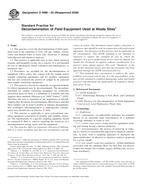Potřebujeme váš souhlas k využití jednotlivých dat, aby se vám mimo jiné mohly ukazovat informace týkající se vašich zájmů. Souhlas udělíte kliknutím na tlačítko „OK“.
ASTM D5088-02(2008)
Standard Practice for Decontamination of Field Equipment Used at Waste Sites
Automaticky přeložený název:
Standardní praxe pro dekontaminaci Field zařízení používaném při skládky odpadů
NORMA vydána dne 15.9.2008
Informace o normě:
Označení normy: ASTM D5088-02(2008)
Poznámka: NEPLATNÁ
Datum vydání normy: 15.9.2008
Kód zboží: NS-29788
Počet stran: 4
Přibližná hmotnost: 12 g (0.03 liber)
Země: Americká technická norma
Kategorie: Technické normy ASTM
Anotace textu normy ASTM D5088-02(2008) :
Keywords:
contaminant, decontamination, sampling, waste, Contamination--waste, Decontamination, Field testing--soil, Ground water, Nonradioactive waste sites, Sludge, Soil, Soil gas analysis, Soil sampling, Surface water, Waste materials/processing/analysis, ICS Number Code 13.030.40 (Installations and equipment for waste disposal and treatment)
Doplňující informace
| Significance and Use | ||||
|
An appropriately developed, executed and documented equipment decontamination procedure is an integral and essential part of waste site investigations. The benefits of its use include: Minimizing the spread of contaminants within a study area and from site to site, Reducing the potential for worker exposure by means of contact with contaminated sampling equipment, and Improved data quality and reliability. This practice is not a substitute for a well-documented Quality Assurance/Quality Control (QA/QC) program. Because the ultimate test of a decontamination procedure is its ability to minimize erroneous data, a reasonable QA/QC program must be implemented. This practice may not be applicable to all waste sites. When a sampling effort is completed to determine only the general range of chemical concentrations of interest less rigorous decontamination procedures can be adequate. Investigators should have the flexibility to modify the decontamination procedures with due consideration for the sampling objective or if QA/QC documentation supports alternative decontamination methods. At sites where the reactivity of sampling equipment to decontamination washes creates concern for the generation of undesirable chemical by-products, the use of dedicated sampling equipment should be considered. This practice, where applicable, should be used before, between, and after the completion of sampling events. This practice is appropriate for use at sites where chemical (organic and inorganic) contamination is known or expected. The application of this practice to other types of sites radiological, mixed (radiological and chemical), or biohazard contaminated sites may not be applicable. The application of this practice to these types of sites should be undertaken with care and consideration, along with QA/QC documentation that supports the effectiveness of these decontamination techniques. |
||||
| 1. Scope | ||||
|
1.1 This practice covers the decontamination of field equipment used in the sampling of soils, soil gas, sludges, surface water, and groundwater at waste sites which are to undergo both physical and chemical analyses. 1.2 This practice is applicable only at sites where chemical (organic and inorganic) wastes are a concern. It is not intended for use at radiological, mixed (chemical and radiological), or biohazard sites. 1.3 Procedures are included for the decontamination of equipment which comes into contact with the sample matrix (sample contacting equipment) and for ancillary equipment that has not contacted the portion of sample to be analyzed (non-sample contacting equipment). 1.4 This practice is based on commonly recognized methods by which equipment may be decontaminated. The procedures described for sample contacting equipment are commonly prescribed, however there is a minimum of scientific data that supports these methods (Mickam et al. 1989 , Parker , 1995). Therefore the user is reminded of the importance of QA/QC samples that document decontamination effectiveness and that these samples can be used to modify or enhance decontamination techniques. Decontamination at radiologically contaminated sites should refer to Practice D5608. 1.5 This practice is applicable to most conventional sampling equipment constructed of metallic and synthetic materials. The manufacturer of a specific sampling apparatus should be contacted if there is concern regarding the reactivity of a decontamination rinsing agent with the equipment. 1.6 This practice offers an organized collection of information or a series of options and does not recommend a specific course of action. This document cannot replace education or experience and should be used in conjunction with professional judgement. Not all aspects of this practice may be applicable in all circumstances. This ASTM standard is not intended to represent or replace the standard of care by which the adequacy of a given professional service must be judged, nor should this document be applied without consideration of a project's many unique aspects. The word “Standard” in the title of this document means only that the documents has been approved through the ASTM consensus process.. 1.7 This standard does not purport to address the safety problems associated with its use. It is the responsibility of the user of this standard to establish appropriate safety and health practices and determine the applicability of regulatory limitations prior to use. |
||||
| 2. Referenced Documents | ||||
|
Odebírejte informace o nově vydaných normách ZDARMA:
Chcete pravidelně odebírat informace o nově vycházejících normách z celého světa a to zcela zdarma?
Přihlašte se k odběru. Vše je velice jednoduché a absolutně ZDARMA.
Na výběr máte vydavatele z celého světa.




 Cookies
Cookies
